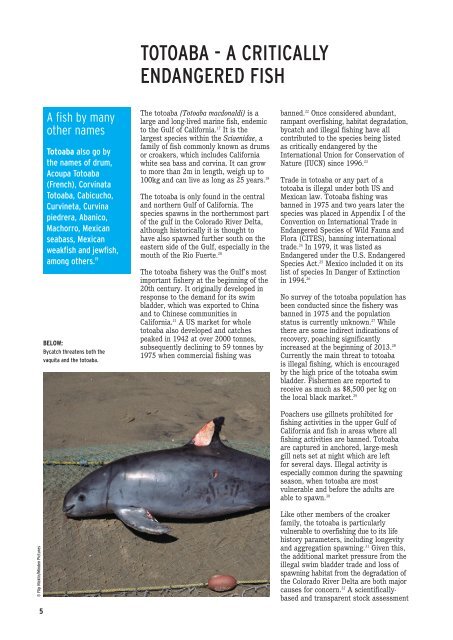DUAL EXTINCTION
EIA-Dual-Extinction
EIA-Dual-Extinction
You also want an ePaper? Increase the reach of your titles
YUMPU automatically turns print PDFs into web optimized ePapers that Google loves.
TOTOaBa - a CrITICaLLy<br />
ENDaNGErED FISH<br />
© Flip Nicklin/minden Pictures<br />
5<br />
A fish by many<br />
other names<br />
Totoaba also go by<br />
the names of drum,<br />
acoupa Totoaba<br />
(French), Corvinata<br />
Totoaba, Cabicucho,<br />
Curvineta, Curvina<br />
piedrera, abanico,<br />
machorro, mexican<br />
seabass, mexican<br />
weakfish and jewfish,<br />
among others. 19<br />
bELOw:<br />
Bycatch threatens both the<br />
vaquita and the totoaba.<br />
The totoaba (Totoaba macdonaldi) is a<br />
large and long-lived marine fish, endemic<br />
to the Gulf of California. 17 It is the<br />
largest species within the Sciaenidae, a<br />
family of fish commonly known as drums<br />
or croakers, which includes California<br />
white sea bass and corvina. It can grow<br />
to more than 2m in length, weigh up to<br />
100kg and can live as long as 25 years. 18<br />
The totoaba is only found in the central<br />
and northern Gulf of California. The<br />
species spawns in the northernmost part<br />
of the gulf in the Colorado River Delta,<br />
although historically it is thought to<br />
have also spawned further south on the<br />
eastern side of the Gulf, especially in the<br />
mouth of the Rio Fuerte. 20<br />
The totoaba fishery was the Gulf’s most<br />
important fishery at the beginning of the<br />
20th century. It originally developed in<br />
response to the demand for its swim<br />
bladder, which was exported to China<br />
and to Chinese communities in<br />
California. 21 A US market for whole<br />
totoaba also developed and catches<br />
peaked in 1942 at over 2000 tonnes,<br />
subsequently declining to 59 tonnes by<br />
1975 when commercial fishing was<br />
banned. 22 Once considered abundant,<br />
rampant overfishing, habitat degradation,<br />
bycatch and illegal fishing have all<br />
contributed to the species being listed<br />
as critically endangered by the<br />
International Union for Conservation of<br />
Nature (IUCN) since 1996. 23<br />
Trade in totoaba or any part of a<br />
totoaba is illegal under both US and<br />
Mexican law. Totoaba fishing was<br />
banned in 1975 and two years later the<br />
species was placed in Appendix I of the<br />
Convention on International Trade in<br />
Endangered Species of Wild Fauna and<br />
Flora (CITES), banning international<br />
trade. 24 In 1979, it was listed as<br />
Endangered under the U.S. Endangered<br />
Species Act. 25 Mexico included it on its<br />
list of species In Danger of Extinction<br />
in 1994. 26<br />
No survey of the totoaba population has<br />
been conducted since the fishery was<br />
banned in 1975 and the population<br />
status is currently unknown. 27 While<br />
there are some indirect indications of<br />
recovery, poaching significantly<br />
increased at the beginning of 2013. 28<br />
Currently the main threat to totoaba<br />
is illegal fishing, which is encouraged<br />
by the high price of the totoaba swim<br />
bladder. Fishermen are reported to<br />
receive as much as $8,500 per kg on<br />
the local black market. 29<br />
Poachers use gillnets prohibited for<br />
fishing activities in the upper Gulf of<br />
California and fish in areas where all<br />
fishing activities are banned. Totoaba<br />
are captured in anchored, large-mesh<br />
gill nets set at night which are left<br />
for several days. Illegal activity is<br />
especially common during the spawning<br />
season, when totoaba are most<br />
vulnerable and before the adults are<br />
able to spawn. 30<br />
Like other members of the croaker<br />
family, the totoaba is particularly<br />
vulnerable to overfishing due to its life<br />
history parameters, including longevity<br />
and aggregation spawning. 31 Given this,<br />
the additional market pressure from the<br />
illegal swim bladder trade and loss of<br />
spawning habitat from the degradation of<br />
the Colorado River Delta are both major<br />
causes for concern. 32 A scientificallybased<br />
and transparent stock assessment


